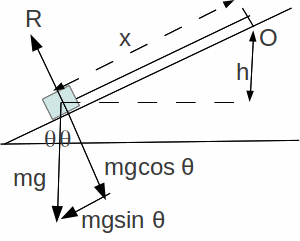The Work Energy Principle states that for an isolated system, as the system proceeds to evolve, the difference between the initial energy and the energy at any instant has been used to overcome air resistance or friction of some sort.
Consider a particle of mass![]() on a rough slope. The coefficient of friction between the particle and the slope is
on a rough slope. The coefficient of friction between the particle and the slope is![]() Initially the particle is at some point O on the slope and with pushed directly down the slope with a speed
Initially the particle is at some point O on the slope and with pushed directly down the slope with a speed![]()

We can take the gravitational potential energy of the particle relative to O.
Initially![]() Since the particle is below O, the gravitational potential energy is always less than or equal to zero. Initially the string is unstretched so has elastic potential energy zero.
Since the particle is below O, the gravitational potential energy is always less than or equal to zero. Initially the string is unstretched so has elastic potential energy zero.
Initially the kinetic energy is![]()
At any subsequent time, the gravitational potential energy i![]() the kinetic energy is
the kinetic energy is![]() If the natural length of the string is l then the extension for x
If the natural length of the string is l then the extension for x ![]() and the stored elastic potential energy is
and the stored elastic potential energy is![]()
The reaction force![]() (resolving perpendicular to the slope in the diagram above) so the force of friction
(resolving perpendicular to the slope in the diagram above) so the force of friction![]() In moving a distance
In moving a distance![]() the work done against friction is
the work done against friction is![]()
At any time the work energy principle states:
![]()
![]() for
for![]()
![]() for
for![]()
